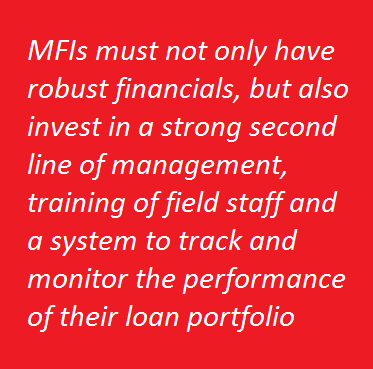Sucharita Mukherjee and Kirthi Rao talk about the importance of quality of underwriting standards in microfinance institutions. This is the first in a series of articles by the authors on the topic “Unearthing the real issues in microfinance”.
Recently, the media coverage on the evolution of microfinance has taken on a worried tone about the future of the sector. Forthcoming IPOs from large Indian microfinance institutions (MFIs) after a period of ‘runaway’ growth fuelled by the ‘irrational exuberance’ of private equity and the declining asset quality in some countries such as Nicaragua and Pakistan seems to have raised grave concerns. Also pointed out are political risk, lack of regulation and the nascent level of self-regulation in the industry with the inference that a tightening of standards will bring about a meltdown. IFMR Capital, with its deep understanding and involvement in the sector, has reason to believe that these worries are misplaced.
Indeed, the microfinance sector has grown tremendously (portfolio outstanding of Indian MFIs grew at 102% between 2008 and 2009), this can be attributed to two reasons: the strength of the underlying “Grameen” model of uncollateralised lending, and the vast unmet demand for credit within low income households in India.
Vast unmet demand
A variety of public policy measures such as the promotion of cooperative banks, regional rural banks and local area banks, bank nationalisation, loan waivers, recapitalisation of failing cooperative banks and regulation directing lending to priority sectors by commercial banks, have been aimed at providing access to finance more broadly in India. However, financial inclusion still remains a distant dream. This is illustrated by the fact that only 2.9% of the lowest income quartile has a loan from a formal institution. As per the CRISIL Top 50 MFIs report, India still represents the largest microfinance market, with only about 10% of the demand being met by existing MFIs. CRISIL’s report estimates the figure for credit demand by low income households at least INR 1.2 trillion, a small fraction of which is the current size of the microfinance sector.
Multiple asset evaluation criteria
The “Grameen” model is a pioneering development, in that it enables “good” selection of borrowers by leveraging on rich information possessed by the members of the group that cross guarantees each other. Most microfinance institutions (MFIs) in India today follow the “Grameen” model. The strength of the “Grameen” model has been amply demonstrated by strong equity investor appetite, bank funding and very low defaults despite no subsidies. This model, with a standard structure of lending to joint liability groups has the twin features of being both strong and replicable. Rapid growth is possible, provided MFIs follow the operational framework of this model with rigour. This implies that these MFIs must not only have robust financials, but also invest in a strong second line of management, training of field staff and a system to track and monitor the performance of their loan portfolio. These are some of the factors that debt investors consider when evaluating MFI asset quality. These criteria have been synthesised into Underwriting Standards, by CRISIL and IFMR Capital. The performance of MFIs can be tracked not only by rating agencies but also is publicly available on the IFMR Capital Deal Portal. While political risk in this asset class can certainly not be ruled out, the performance of MFIs till date has been driven by how well each MFI follows the Underwriting Standards.
by leveraging on rich information possessed by the members of the group that cross guarantees each other. Most microfinance institutions (MFIs) in India today follow the “Grameen” model. The strength of the “Grameen” model has been amply demonstrated by strong equity investor appetite, bank funding and very low defaults despite no subsidies. This model, with a standard structure of lending to joint liability groups has the twin features of being both strong and replicable. Rapid growth is possible, provided MFIs follow the operational framework of this model with rigour. This implies that these MFIs must not only have robust financials, but also invest in a strong second line of management, training of field staff and a system to track and monitor the performance of their loan portfolio. These are some of the factors that debt investors consider when evaluating MFI asset quality. These criteria have been synthesised into Underwriting Standards, by CRISIL and IFMR Capital. The performance of MFIs can be tracked not only by rating agencies but also is publicly available on the IFMR Capital Deal Portal. While political risk in this asset class can certainly not be ruled out, the performance of MFIs till date has been driven by how well each MFI follows the Underwriting Standards.
The CRISIL report states “MFI asset quality indicated by their portfolio at risk (PAR) greater than 30 days, is healthier than those of other financial service players in India. MFIs have maintained relatively healthy asset quality mainly because of strong group pressure and efficient collection mechanisms, which have ensured high repayment rates. The asset quality is expected to remain superior to asset classes such as vehicle loans, credit card receivables and small ticket personal loans.”
Strong underwriting standards is the key
Concerns about an impending collapse a la the US sub-prime crisis in the media seem to emanate largely from opinion rather than fact. The sub-prime crisis was characterised by poor underwriting standards, lack of incentives for mortgage finance companies to originate high quality portfolios as most loans originated were sold down immediately, and overly aggressive rating models assuming very low loss rates, correlations and an unstated assumption of “house prices cannot fall”! The microfinance sector has demonstrated default rates under 2% for more than five years, is financed largely by on-balance sheet loans, and MFIs retain a strong incentive for good due diligence and follow up as they hold first loss equity positions in rated off balance sheet securitisations that are several multiples of their historical default rates. What we must learn from the sub-prime crisis is the importance of monitoring the quality of underwriting standards of originators, and the need to invest in systems that have such monitoring and supervision capability such that credit flows most reliably and at the best price to the MFIs that are less risky, as measured by their quality of underwriting. The microfinance sector can then deliver on financial inclusion built on a solid, sustainable platform of high quality underwriting and supervision.
The media, we believe, would do well to focus on criteria that truly drive asset quality, such as quality of systems, group loan origination processes, cash management, second line of management and governance practices of MFIs. These institutions are clearly critical for equitable growth in our country, and in order to strengthen them, we need a debate focusing on the real questions raised here.
—
[Sucharita Mukherjee is the CEO and Kirthi Rao is a team member of IFMR Capital Finance Private Limited.]
Let’s talk Quality in Microfinance




3 Responses